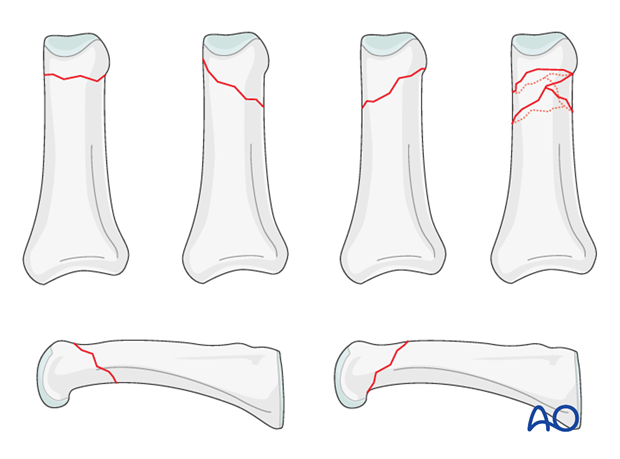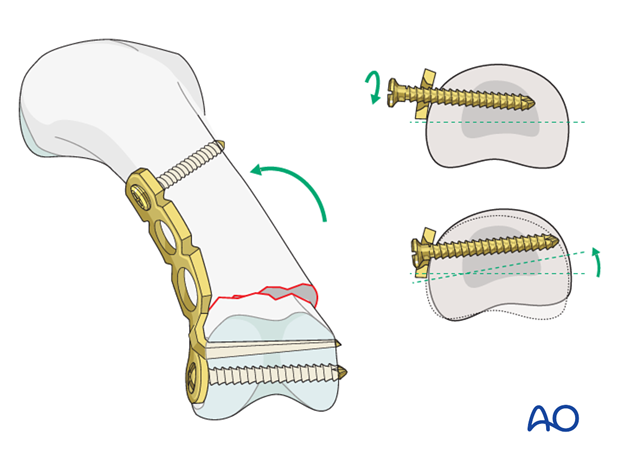Minicondylar compression plate fixation
1. Principles
Indications
Fractures of the distal metaphysis can be transverse, oblique, or comminuted.
Always confirm the fracture configuration in views from both planes.
Stable undisplaced fractures can be treated nonoperatively. Any displacement or instability will usually require ORIF.
Other indications for ORIF are open fractures, or soft-tissue lacerations. In these cases, ORIF is the best option.

Reduction principles
Indirect reduction is achieved by traction and manipulation.
Sometimes indirect reduction may be prevented by interposition of the lateral band.
If the fracture is irreducible, ORIF is indicated.

2. Approach
For this procedure a midaxial approach to the proximal phalanx is normally used.

3. Reduction
Indirect reduction by traction
Reduction can be achieved by traction and flexion exerted by the surgeon, or by two pointed reduction forceps.
Confirm reduction under image intensification.
Often, these fractures are stable after reduction. In such cases, nonoperative treatment is indicated.

Direct reduction
Direct reduction is necessary when the fracture can not be reduced by traction and flexion, or is unstable.
When indirect reduction is not possible, this is usually due to interposition of parts of the extensor apparatus.
Use a pointed reduction forceps for direct reduction.

Preliminary fixation
Pointed reduction forceps, or a K-wire, may be used for preliminary fixation. However, in many cases the position of the forceps, or the K-wire, will conflict with the planned plate, or screw position.
For that reason, in many cases, the reduction is preliminarily held by an assistant’s holding the finger in flexion. If the extensor apparatus is intact, it will act as a tension band and hold the reduction.

4. Plate preparation
Planning plate position
It is wise to use magnifying loupes for this step.
Plan the blade position as dorsal as possible, in order not to injure the collateral ligament.
Make sure that the plate will be perfectly aligned with the long axis of the proximal phalanx in the lateral view.

Contouring of the plate
As the minicondylar plate has notches (like a reconstruction plate), it can also be curved on the flat to fit the curve of the phalanx.
Note
It is worth investing time in the precise contouring of the plate to the phalanx. Any imperfection in contouring will result in fracture displacement when the diaphyseal screws are tightened.

Determine location of drill hole
In order to determine the position of the first drill hole (for the blade), it can be very helpful to turn the plate over and use it as a template.

Trim the plate
Adapt the plate length to fit the length of the proximal phalanx. Avoid sharp edges which may be injurious to the tendons. There should be at least 3 plate holes distal to the fracture available for fixation in the diaphysis. At least two screws need to be inserted into the diaphysis.
Pearl: Cut the blade transversely
If you cut the blade on the flat, it will compress and widen very slightly as it is cut. This makes its maximal width very slightly larger than 1.5 mm. It may not fit in the 1.5 mm hole that you have drilled.
Therefore, cut the blade on edge (to deform it through its narrower dimension) to the correct length. The resultant tip is somewhat arrow-shaped.

Pitfall: avoid dangerous edge
When cutting the plate, be very careful not to create a sharp dorsal edge that will endanger the extensor apparatus. Correct cutting will produce the sharp edge on the bone side of the plate.

5. Drilling
Drill a 1.5 mm transverse hole through the condylar metaphysis of the proximal phalanx, adjacent to the subchondral bone.

The drill hole needs to be sufficiently dorsal to leave enough space for the plate hole adjacent to the blade.

Prepare the blade
Measure the length of the drill hole.
Cut the blade to the determined length, so that it just fills the drill hole.

Pitfall: Protrusion of the blade
Avoid protrusion of the blade through the opposite cortex, as friction during movement and eventual ligament injury may result.
Due to the fact that the phalanx is wider on the palmar side that on the dorsal side, an AP or PA x-ray view may suggest that the blade is fully contained within the bone, whereas in transverse section, it actually protrudes.

6. Plate application
Introduce the blade into the drill hole. Gently push with the thumb until the plate is fully seated.

Align the plate with the diaphysis
Before inserting distal screw adjacent to the blade, ensure that the plate is in line with the phalangeal diaphysis in the lateral view by rotating it around the long axis of the blade.
Insert distal screw
The distal screw is then inserted in a neutral position.
The screw should just engage the far cortex.
Note
Be careful to avoid screw protrusion, as ligament injury may result from friction during movement.

Drill eccentric proximal hole
Use a 1.1 mm drill bit to prepare the first diaphyseal screw hole at the proximal end of the plate.
This hole must be eccentrically drilled to produce axial compression.

Fracture compression
Measure for screw length and insert an eccentric self-tapping 1.5 mm screw.
Tightening the screw will compress the fracture axially.

Pitfall: loss of reduction
While tightening this second screw, a maladapted plate may cause rotational displacement and result in loss of reduction.
Be sure to check the reduction using image intensification after this step.

Insert remaining screws
Insert the remaining diaphyseal screws in neutral positions.

Completed osteosynthesis
The x-ray shows a completed osteosynthesis of the condylar metaphysis with a minicondylar plate.

7. Aftertreatment
Postoperatively
Protect the digit with buddy strapping to the adjacent finger, to neutralize lateral forces on the finger.

Functional exercises
The patient can begin active motion (flexion and extension) immediately after surgery.

Follow-up
See patient after 5 days and 10 days of surgery.
Implant removal
The implants may need to be removed in cases of soft-tissue irritation.
In case of joint stiffness, or tendon adhesion’s restricting finger movement, tenolysis, or arthrolysis become necessary. In these circumstances, take the opportunity to remove the implants.













